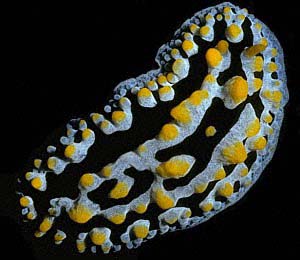
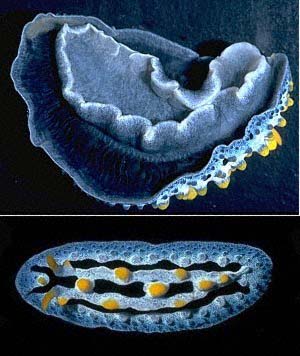
Phyllidia coelestis
Bergh, 1905
Order: NUDIBRANCHIA
Suborder: DORIDINA
Family: Phyllidiidae
DISTRIBUTION
Common on tropical reefs throughout the Indo-West Pacific Ocean. Known from the western Pacific Ocean, South China Sea, Timor Sea and across the Indian Ocean to South Africa.
PHOTO
UPPER: 8 m depth, Loloata Island, 15 km south-east of Port Moresby, PNG, 23 June 1988, dorsal view of 39 mm specimen (Brunckhorst, 1993: Plate 1G);
MIDDLE: 1 m depth, Phi Phi Island, southern Thailand, 24 Nov. 1989, ventral view of 55 mm specimen. (Brunckhorst, 1993: Plate 1H).
LOWER: 18-24 m depth, Horseshoe Reef, 23 km south-east of Port Moresby, PNG, 21 June 1988, dorsal view of 20 mm specimen (Brunckhorst, 1993: Plate 1F).
PHOTOS: David Brunckhorst.
RELATED TOPIC
Symbiotic copepod on P. coelestis
Notes compiled from Brunckhorst, 1993:
Phyllidia coelestis can be distinguished from other similar-looking phyllidiids by colour and pattern: in particular the "Y" shape of the blue-grey dorsal ridges; the yellow-capped mid-dorsal tubercles (which never form a median ridge as in Phyllidia varicosa); the evenly tuberculate, broad, blue-grey mantle margin; and the uniformly grey foot without a dark stripe.
Reference:
• Brunckhorst, D.J. (1993) The systematics and phylogeny of Phyllidiid Nudibranchs (Doridoidea). Records of the Australian Museum, Supplement 16: 1-107.
Rudman, W.B., 1999 (January 12) Phyllidia coelestis Bergh, 1905. [In] Sea Slug Forum. Australian Museum, Sydney. Available from http://www.seaslugforum.net/find/phylcoel
Related messages
Variants of Phyllidia coelestis from Reunion
November 12, 2008
From: Hugues Flodrops
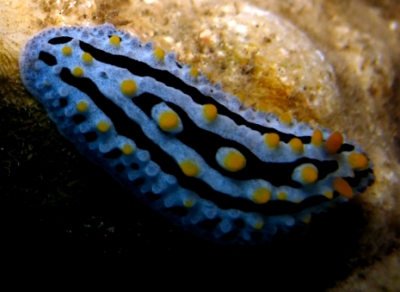
Hi Bill,
Here are two specimen of Phyllidia coelestis with variation on the median black band.
Upper Photo: The median black band isn't broken by yellow tubercules. Passe de l'hermitage, 12 metres, Reunion Island, Indian Ocean. 20 December 2006, Length 30 mm. Photographer: Hugues Flodrops.
Lower Photo: More typical pattern, with median black band on the mantle which is broken by yellow tubercles. Sec jaune, 10 metres, Reunion Island, Indian Ocean, 3 November 2008. Length: 35 mm. Photographer: Hugues Flodrops.
Best regards .
Hugues.
hugues.flodrops@wanadoo.fr
Flodrops, H., 2008 (Nov 12) Variants of Phyllidia coelestis from Reunion. [Message in] Sea Slug Forum. Australian Museum, Sydney. Available from http://www.seaslugforum.net/find/22033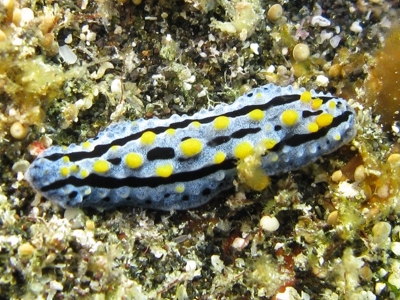
Thanks Hugues,
The median black band seems to be quite variable in shape in this species. Of your two animals, the one in the lower photo seems to be the most unusual in that the black band is much narrower than we normally see in this species.
Best wishes,
Bill Rudman
Re: Phyllidia coelestis mating
August 5, 2008
From: Gary Cobb
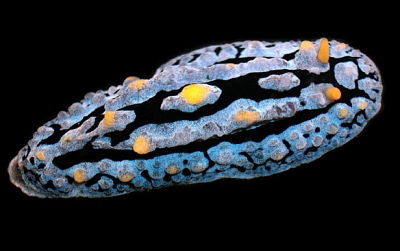
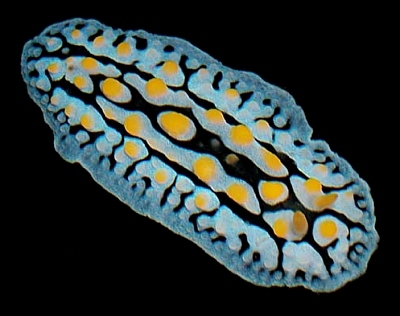
Concerning message #21559:
Hi Bill and everyone!
After reading the entry on Phyllidia coelestis I thought you might like to see three animals we have found here on the Sunshine Coast. The average size is 40 mm.
Locality: Mooloolaba, Sunshine Coast, 10-16m, Queensland, Australia, Pacific Ocean, 01 December 2007, Subtidal. Length: 40 mm. Photographer: Gary Cobb.
Cheers
Gary Cobb
gary@nudibranch.com.au
Cobb, G.C., 2008 (Aug 5) Re: Phyllidia coelestis mating. [Message in] Sea Slug Forum. Australian Museum, Sydney. Available from http://www.seaslugforum.net/find/21754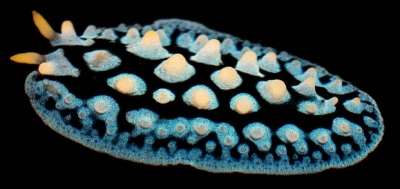
Thanks Gary,
Although the first two of your photos look to be typical P. coelestis I have a feeling that the lower one is something different. The solid black background colour reminds me of a species of Fryeria, perhaps F. picta. I am afraid identifying phyllidiids just from photos can be a problem at times.
Best wishes,
Bill Rudman
Phyllidia coelestis mating
July 30, 2008
From: Leanne & David Atkinson
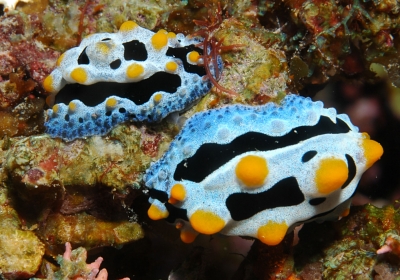
Concerning message #9399:
Dear Bill,
Thought we'd send this after your recent comment that the forum doesn't have many photos of Phyllidiids mating. We think this is Phyllidia varicosa mating. You do already have Mary Jane's shot but it doesn't show as much of the genitals as these photos do. Because they are clear we didn't notice the genitals until we put the photo on the computer. The two photos are the same animals from diffferent angles. We thought they were feeding and took the different angles to try to confirm it.
Locality: White Rock, Moso Island, 15 metres, Vanuatu, Pacific, 22 April 2008, Coral Reef. Length: 40 mm approximately. Photographer: Leanne & David Atkinson.
It is also a possible addition to the range since we couldn't see a message with animals from Vanuatu.They were one of the most common nudibranchs for us to find both on this trip in April and the one in July last year. The water temperature was a very comfortable 29 degrees celcius. Can you confirm the identity?
Thankyou,
Leanne & David Atkinson
atk@hunterlink.net.au
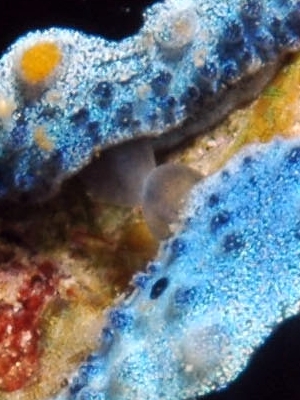
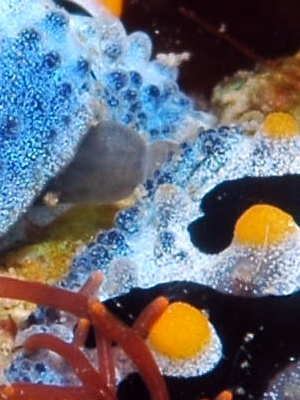
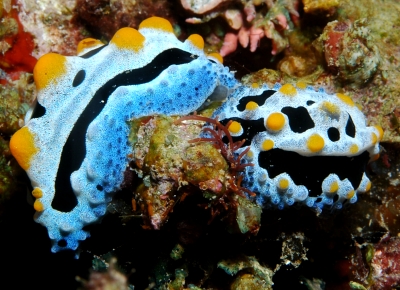
Dear Leanne & David,
Thanks for this nice observation. However the animals are in fact Phyllidia coelestis. One clue to its identity is the the median black band on the mantle which is broken by the yellow-tipped tubercles. In P. varicosa there is a bluish ridge down the dorsal midline with black bands on either side.
Best wishes,
Bill Rudman
Juvenile Phyllidia coelestis
February 10, 2006
From: Dave Morgan
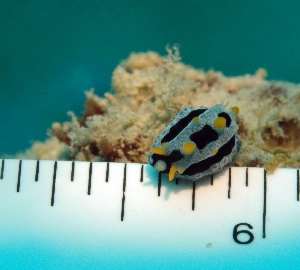
Dear Bill,
My knowledge is limited I know, but Ii have searched to find other examples the same as my specimen and have been unsuccsesful. I can find similar, i have guessed at Phyllidia????
Locality: Seaventures Platform, Mabul, Sabah, Celebes sea. Depth: 17-18 m. Length: 3/8th inch or 8 mm. July 2005. Sandy bottom coral heads. Photographer: Dave Morgan
Can you identify for me please.
Thanks
Dave Morgan.
dave@seatreker.com
Morgan D A, 2006 (Feb 10) Juvenile Phyllidia coelestis. [Message in] Sea Slug Forum. Australian Museum, Sydney. Available from http://www.seaslugforum.net/find/15759Dear Morg,
It is clearly a juvenile animal but the adult colur pattern is already there. It is Phyllidia coelestis. I guess the most distinctive features are the central black band which is broken by the yellow tubercles, and the yellow rhinophores.
Best wishes,
Bill Rudman
Phyllidia coelestis from Indonesia
December 24, 2004
From: Ulrike Stollenwerk
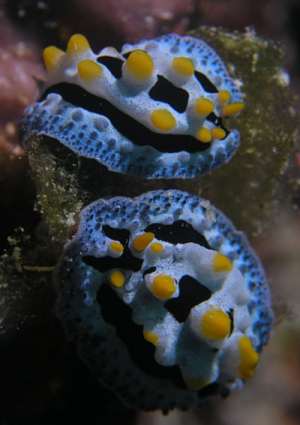
Hi,
I found a pair of Phyllidia varicosa and was wondering if they are juveniles?
I took the photo on Starship Reef in Wakatobi marine park in Indonesia on March 29, 2004.
Best regards,
Ulrike Stollenwerk
ulrike_stollenwerk@mac.com
Stollenwerk, U., 2004 (Dec 24) Phyllidia coelestis from Indonesia. [Message in] Sea Slug Forum. Australian Museum, Sydney. Available from http://www.seaslugforum.net/find/12631Dear Ulrike,
This is Phyllidia coelestis. One immediate difference from Phyllidia varicosa is the median black band on the mantle.Without some indication of size from you I have no idea whether these are juveniles or not
Best wishes
Bill
Phyllidia coelestis from Mayotte
December 20, 2003
From: Marina Poddubetskaia
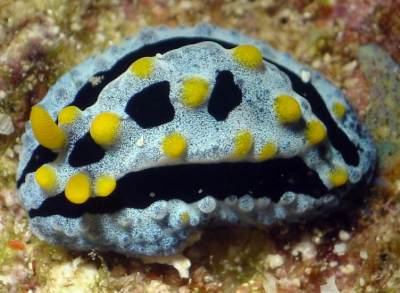
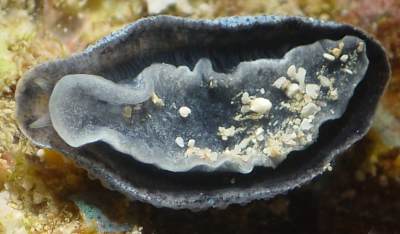
Dear Bill,
Here is a photo of Phyllidia coelestis from Indian Ocean. This animal was found during my collecting mission in Mayotte (the Comoros).
Date: November 04, 2003
Location: Mayotte Island, France, Indian Ocean
Site: Passe en S, buoy n° 8bis
Depth: 13.5m
Size: 13-15mm
Best wishes,
Marina.
nembro@nembro.info
Poddubetskaia, M., 2003 (Dec 20) Phyllidia coelestis from Mayotte. [Message in] Sea Slug Forum. Australian Museum, Sydney. Available from http://www.seaslugforum.net/find/11603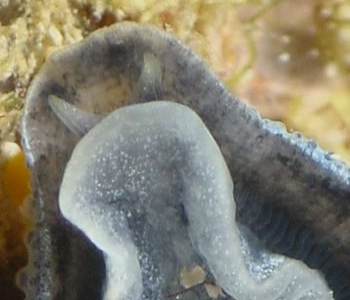
Thanks Marina,
Bill Rudman
Phyllidia coelestis from West Malaysia
June 19, 2002
From: Kheong Sann Chan
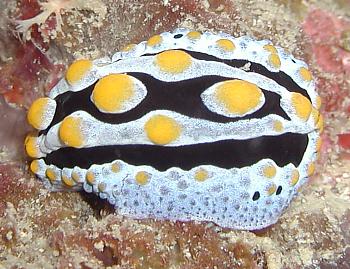
Here are some more photos from Pulau Dayang off the east coast of west Malaysia.
Location: Pulau Dayang, Pinang
Date : 8 June, 2002, 1800hrs
Depth : 7m
Kheong
kschan@mail.dsi.nus.edu.sg
Chan, K.S., 2002 (Jun 19) Phyllidia coelestis from West Malaysia. [Message in] Sea Slug Forum. Australian Museum, Sydney. Available from http://www.seaslugforum.net/find/7255Dear Kheong,
This is Phyllidia coelestis.
Best wishes,
Bill Rudman
Phyllidia coelestis or P. varicosa?
October 7, 2001
From: Des Paroz


Hi Bill
Attached are photos of what I think is a Phyllidia coelestis. Not sure, as they are similar, but I think that this does not have the ridge found on the P. varicosa.
Found at "The Muck", Tufi Wharf, Papua new Guinea, in about 10m. Water temp 28C.
Best regards
Des
des@paroz.com
Paroz, D., 2001 (Oct 7) Phyllidia coelestis or P. varicosa?. [Message in] Sea Slug Forum. Australian Museum, Sydney. Available from http://www.seaslugforum.net/find/5399Dear Des,
Yes this is P. coelestis. The simplest difference to see in a photo is that P. coelestis has a broken black band down the midline and a ridge on each side of it, while in
Best wishes,
Bill Rudman
Phyllidia coelestis from Indonesia
December 31, 2000
From: Yasman
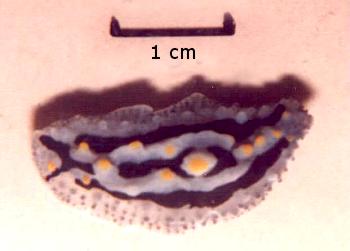
Dear Bill,
Here is Phyllidia coelestis I found at depth of 50-80 feets in Karang Lebar Atoll, Thousand Islands, Indonesia.
Regards,
Yasman
y.yasman@mailcity.com
Yasman, 2000 (Dec 31) Phyllidia coelestis from Indonesia. [Message in] Sea Slug Forum. Australian Museum, Sydney. Available from http://www.seaslugforum.net/find/3339Thanks Yasman,
Bill Rudman.
